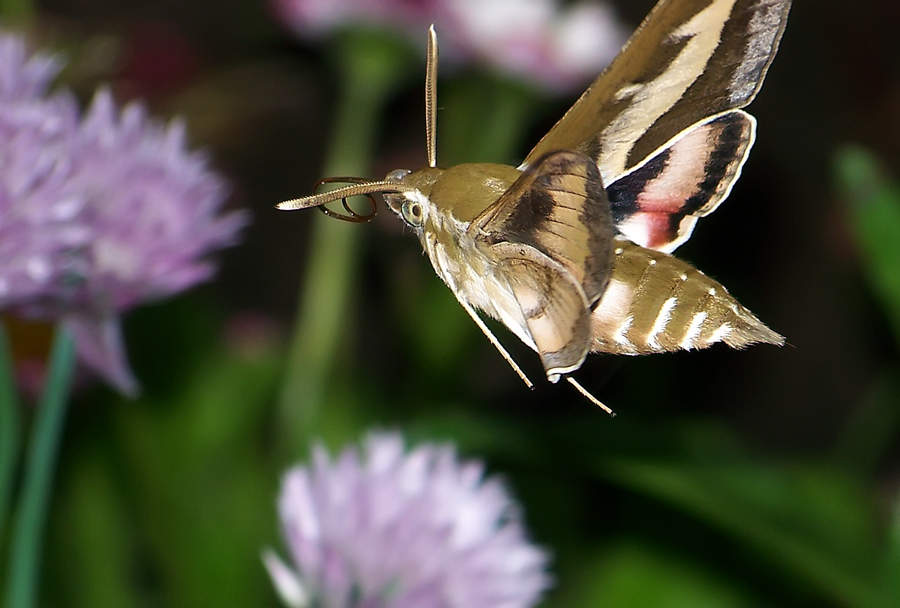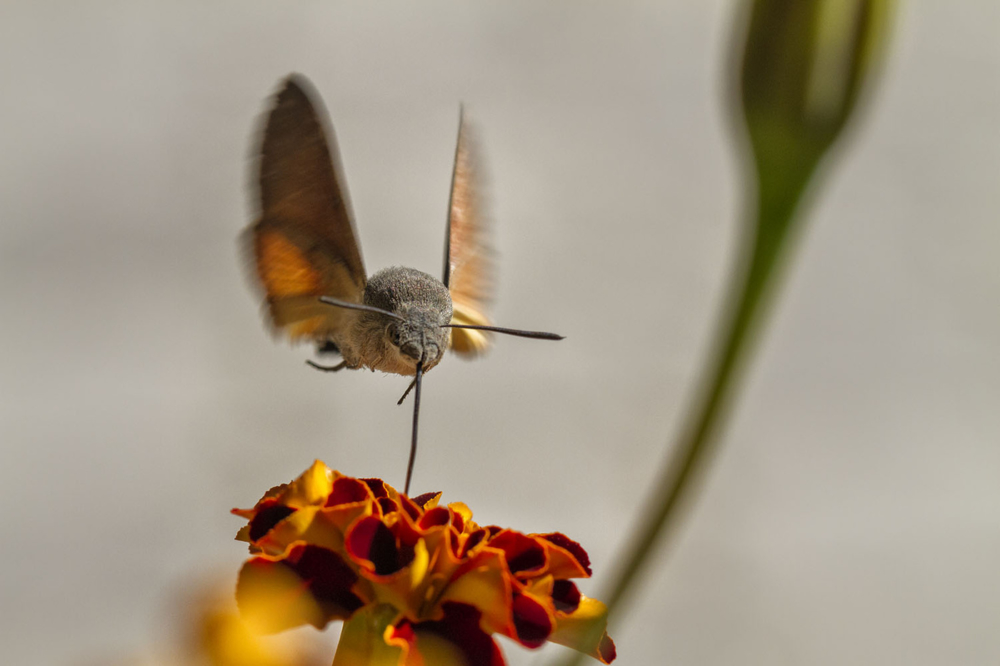Brazhniki is the name of a family of large and medium sized butterflies. One of the main features of these insects is a long proboscis. Brazhnik butterfly does not sit on a flower, but hovering above it, lowering its proboscis on the fly for feeding nectar.
Material Content:
Characteristics and habitat of the moth butterfly
The family of hawks includes about 1200 species, in the fauna of Russia there are no more than 50. These are heat-loving lepidopteran insects, good flyers, developing speeds of up to 50 km / h. Butterflies are mostly nocturnal.
Another important feature is that all hawks need protection from the state.
The front wings of butterflies of this family are relatively narrow and long, the hind wings are short. The antennae are clearly visible due to their considerable thickness, spindle-shaped shape. The proboscis is long, in some species the tone is shortened.
Brazhnik dead head - the largest representative of this family in Russia. The body is conical. The wingspan reaches 11–13 cm, weight - 9 g. The insect got its name because of the yellow pattern on the furry back, outlines similar to a skull with crossbones (as in the photo).
Such an image is not clear in all instances. The chest is brown. The color of the wings is variable: the differences are in the location, color intensity of the stripes and spots. The caterpillar is very large (15 cm), having a tail horn in the last segment of the body.
 A large wine-brewer is a rare species. The butterfly is large or slightly smaller, 6–7 cm long. The wingspan is up to 8 cm. These brightly colored butterflies are pollinators of plants. Medium and small wine barrages are common species in southern Siberia and central Russia.
A large wine-brewer is a rare species. The butterfly is large or slightly smaller, 6–7 cm long. The wingspan is up to 8 cm. These brightly colored butterflies are pollinators of plants. Medium and small wine barrages are common species in southern Siberia and central Russia.
The wingspan of a small wine-brewer is from 4 to 5.5 cm. The antennae are white, the body is pink. The front wings are yellow-olive with wide pink edges, the hind ones have a buffy hue. Butterfly flies from May to August. The caterpillar is gray-brown in color with dark dots, strokes.
Wine middle shrimp - an individual with a predominance of olive color. On the wings and torso there are patterns in the form of stripes and spots of pink color. The hind wings also have a black base. The antennae are grayish pink. The wingspan is more than 6 cm.
The habitat of most species of hawks - forests, marshy areas, parks, gardens in Europe, Asia and North Africa. Butterflies of this family prefer dry habitats, areas well-warmed by the sun. In the European part of the range, hawks adapted to cultural landscapes, became a common occurrence in the fields, in gardens and settlements.
Character and lifestyle
Almost all hawks are moths. They are active at dusk or at night, some species fly during the day. They feed on nectar of flowers, hovering over them like hummingbird birds in hot countries. In this comparison, a paradox is concluded: hummingbirds are the smallest birds with a weight of 2 g, hawks are one of the largest butterflies.
Brazhnik the dead head flies in the evening and at night, gets through open doors and windows in the houses.
 This is a common view in southern Europe, in Africa. The butterfly migrates annually to the north, forms colonies. Directions of flights - Northern, Eastern and Central Europe, Middle Urals. Many types of hawks are able to migrate. They leave their permanent habitats, heading to more northern regions.
This is a common view in southern Europe, in Africa. The butterfly migrates annually to the north, forms colonies. Directions of flights - Northern, Eastern and Central Europe, Middle Urals. Many types of hawks are able to migrate. They leave their permanent habitats, heading to more northern regions.
Insect diet
Insects with a long thin proboscis are best suited for feeding in flight. They swirl over flowers, suck out nectar. Sometimes they sit on flowers.
 Adults and larvae of Brazhnik, a dead head, belong to omnivores (polyphages). The proboscis of the butterfly is short, which complicates the use of nectar of flowers. He finds food on trees - he sucks out juice, “falls” to damaged berries and fruits, and is not averse to enjoying the honey of wild and domestic bees. The cuticle protects the body of the butterfly from the hymenoptera venom.
Adults and larvae of Brazhnik, a dead head, belong to omnivores (polyphages). The proboscis of the butterfly is short, which complicates the use of nectar of flowers. He finds food on trees - he sucks out juice, “falls” to damaged berries and fruits, and is not averse to enjoying the honey of wild and domestic bees. The cuticle protects the body of the butterfly from the hymenoptera venom.
Caterpillars live on nightshade plants, if this food is not enough, then they move to jasmine, raspberries, euonymus, hawthorn, fruit trees.
Reproduction and Life Cycle
In Africa, hawthorns have a dead head live and breed throughout the year. 2 generations give north annually. Mating occurs at night (the time of activity of the hawks). Butterflies of both sexes fly to light sources. After fertilization, the female lays eggs on the leaves of fodder plants (for caterpillars). The average amount in 1 clutch is 100 pcs.
 In the development cycle of the larva, 5 phases (ages) are successively replaced, during which the growth of the caterpillar takes shape. She feeds on many plants, is a polyphage. In the underground chamber pupation occurs.
In the development cycle of the larva, 5 phases (ages) are successively replaced, during which the growth of the caterpillar takes shape. She feeds on many plants, is a polyphage. In the underground chamber pupation occurs.
Pupa 5–7 cm long has a smooth shiny surface. They are located in the soil in an earthen cocoon. The stage period is 4 weeks. During this period, hawthorn pupae are sensitive to low temperatures and may die from frost.
Where do butterflies winter
In the middle lane, these insects winter in the pupal phase. Cocoons of some species are found in the soil at a depth of 10 cm. Others survive the cold under a layer of foliage, grass, moss. Warm regions are preferred by adult hawks.
Interesting Facts
A dead head butterfly makes sounds like a mournful squeak. This amazing feature has long been a mystery to entomologists. Scientists have found the body of an insect, thanks to which the hawk squeaks like a chick or a bat.
Other interesting facts:
- In the Latin name of the small wine-brewer there is the word "porcellus", meaning "piglet" in the translation. The fact is that from far away the butterfly seems completely pink.
- The larva of the small wine-brewer can relax muscles, simulating death.This is a defense mechanism that helps to avoid bird attacks.
- Butterflies successfully fly across the seas, overcome ridges and highlands more than 3.5 km high.
- Caterpillars of some species raise the front of the body and freeze. This is a threatening pose to scare insectivorous birds and other enemies.
- Another defensive reaction is that the abdomen is inflated in the butterfly of the hawthorn.
 Unusual coloring, nocturnal lifestyle, menacing poses have caused a huge number of superstitions and myths about hawks. Many still believe in them, although each characteristic of insects can be given a scientific explanation.
Unusual coloring, nocturnal lifestyle, menacing poses have caused a huge number of superstitions and myths about hawks. Many still believe in them, although each characteristic of insects can be given a scientific explanation.












